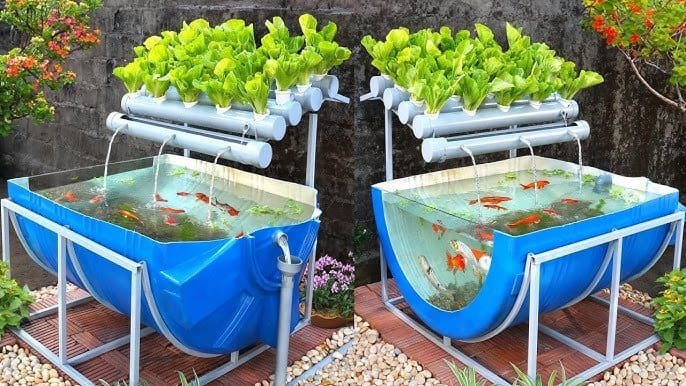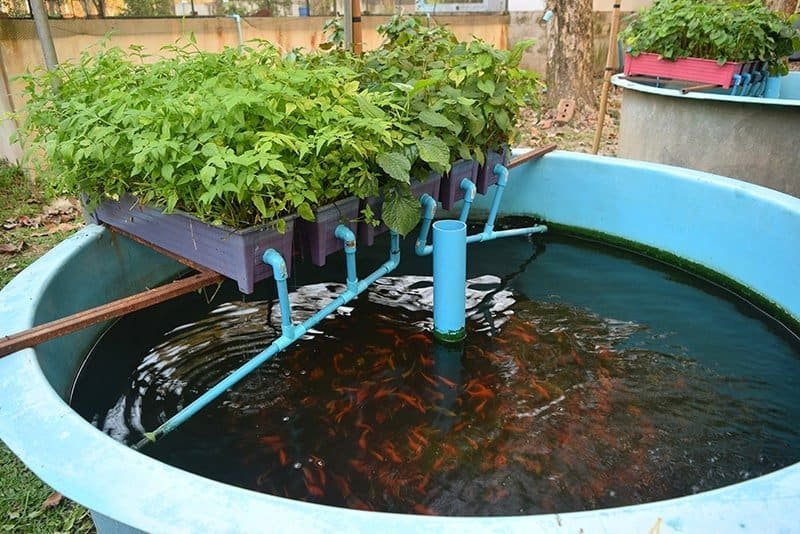To build an aquaponics system for your family, set up a fish tank connected to a grow bed filled with a grow medium, use a water pump to circulate nutrient-rich water from the fish tank to the plants, and incorporate a biofilter to convert fish waste into nutrients for the plants, creating a sustainable cycle.
Grow Your Own Food: A Beginner’s Guide to Building an Aquaponics System for Your Family
Aquaponics is a sustainable farming method that combines aquaculture (raising fish) and hydroponics (growing plants without soil) in a symbiotic environment. The basic concept of aquaponics is to use the waste produced by fish to provide nutrients for plants, and in turn, the plants help to purify the water for the fish. This creates a closed-loop system where both the fish and plants benefit from each other’s presence.
In an aquaponics system, fish waste, which contains ammonia, is broken down by beneficial bacteria into nitrates, which are then absorbed by the plants as nutrients. This process helps to keep the water clean for the fish, while also providing the plants with the necessary nutrients to grow.
The plants, in turn, act as a natural filter, removing the nitrates from the water and returning it clean to the fish. This sustainable and efficient method of farming has gained popularity in recent years due to its ability to produce both fish and vegetables in a small space, with minimal environmental impact.
Choosing the Right Location for Your Aquaponics System
When setting up an aquaponics system, it is important to choose the right location to ensure the success of your venture. The ideal location for an aquaponics system is one that receives plenty of sunlight, as most plants require at least 6-8 hours of direct sunlight per day to thrive.
Additionally, the location should be sheltered from strong winds and extreme temperatures, as these can have a negative impact on the health of both the fish and plants.
It is also important to consider the accessibility of the location, as you will need to regularly monitor and maintain the system. A location that is close to a water source and has access to electricity for pumps and heaters is ideal.
Furthermore, the location should be level and stable to ensure the structural integrity of the system. By carefully considering these factors, you can choose the right location for your aquaponics system and set yourself up for success.
And remember that there are many aquaponics/hydroponics systems to choose from:
| Aquaponics System Type | Description |
|---|---|
| Media-Based Aquaponics | Utilizes a media-filled grow bed where plants grow in a soilless medium (e.g., gravel, expanded clay pellets) that filters the water and provides support for plants. |
| Nutrient Film Technique (NFT) Aquaponics | Uses a shallow channel or tube system to continuously flow nutrient-rich water over plant roots, promoting growth while conserving water and space. |
| Deep Water Culture (DWC) Aquaponics | Plants are suspended directly in nutrient-rich water, allowing roots to access oxygen while receiving nutrients, commonly used for lettuce, herbs, and leafy greens. |
| Vertical Aquaponics | Incorporates vertical grow towers or stacked grow beds to maximize space efficiency, often used in urban settings or where horizontal space is limited. |
| Floating Raft Aquaponics | Plants are grown on floating rafts placed directly on the surface of the water, providing a large surface area for plant growth and promoting efficient nutrient uptake. |
| Hybrid Aquaponics Systems | Combines different aquaponics methods (e.g., media-based, NFT, DWC) to optimize nutrient delivery, space utilization, and plant diversity based on specific needs and goals. |
Selecting the Best Fish and Plants for Your System
Choosing the right fish and plants for your aquaponics system is crucial to its success. When it comes to selecting fish, it is important to choose species that are well-suited to the size and climate of your system.
Tilapia, trout, and catfish are popular choices for aquaponics systems due to their ability to thrive in a wide range of conditions and their fast growth rates. It is important to research the specific requirements of each species and ensure that they are compatible with the other inhabitants of your system.
In terms of plants, leafy greens such as lettuce, spinach, and kale are popular choices for aquaponics systems due to their ability to absorb nutrients from the water and grow quickly.
Herbs such as basil, mint, and cilantro also do well in aquaponics systems and can add flavor and variety to your harvest. When selecting plants for your system, it is important to consider the space and light requirements of each species, as well as their compatibility with the fish in your system.
By carefully selecting the right fish and plants for your aquaponics system, you can create a balanced and thriving ecosystem that produces a bountiful harvest.
Here’s a table outlining some of the best fish and plants commonly used in aquaponics systems:
| Fish Species | Key Characteristics |
|---|---|
| Tilapia | Fast-growing, hardy, tolerate varying water conditions |
| Trout | Cold-water fish, fast growth rate, good for cooler climates |
| Catfish | Hardy, tolerant of poor water quality, suitable for warm climates |
| Koi | Ornamental fish, resilient, colorful, popular in decorative ponds |
| Goldfish | Hardy, colorful, suitable for smaller aquaponics systems |
| Plant Species | Key Characteristics |
|---|---|
| Lettuce | Easy to grow, fast-growing, suitable for most aquaponics systems |
| Herbs (Basil, Mint) | High market value, aromatic, compact growth |
| Kale | Nutrient-rich, cold-hardy, long harvesting period |
| Spinach | Nutrient-rich, quick-growing, suitable for deep water culture |
| Swiss Chard | Colorful, nutritious, tolerant of various growing conditions |
Building the Basic Components of an Aquaponics System
Building the basic components of an aquaponics system requires careful planning and attention to detail. The key components of an aquaponics system include a fish tank, a grow bed, a water pump, and a filtration system.
The fish tank is where the fish are housed and where their waste is collected. The grow bed is where the plants are grown and where the water from the fish tank is circulated to provide nutrients for the plants.
The water pump is used to circulate the water from the fish tank to the grow bed and back again, ensuring that the plants receive a constant supply of nutrients. The filtration system is used to remove solid waste and excess nutrients from the water, keeping it clean and healthy for the fish and plants.
When building the basic components of an aquaponics system, it is important to ensure that the system is properly sized and balanced to support the needs of both the fish and plants. By carefully constructing and integrating these components, you can create a functional and efficient aquaponics system.
| Component | Description |
|---|---|
| Fish Tank | Container to hold fish, typically made of plastic or fiberglass, where fish are raised. |
| Grow Bed | Container filled with a growing medium (e.g., gravel, clay pellets) where plants are cultivated. |
| Water Pump | Device to circulate water from the fish tank to the grow bed, ensuring nutrient distribution. |
| Aeration System | Equipment to oxygenate water in the fish tank, ensuring fish health and optimal microbial activity. |
| Plumbing | Pipes and fittings to connect the fish tank, grow bed, water pump, and aeration system. |
| Biological Filter | Medium for beneficial bacteria to convert fish waste (ammonia) into nutrients for plants (nitrate). |
| pH and Temperature Monitor | Tools to measure and regulate water pH and temperature to maintain optimal conditions. |
| Grow Lights (Optional) | Artificial lighting for indoor systems to supplement natural light and promote plant growth. |
Maintaining Water Quality and Nutrient Levels in Your System
Maintaining water quality and nutrient levels in your aquaponics system is essential to the health and productivity of your fish and plants. One of the key factors in maintaining water quality is monitoring and controlling the levels of ammonia, nitrites, and nitrates in the water.
Ammonia is produced by the fish as waste and can be toxic at high levels, so it is important to regularly test the water and ensure that the levels of ammonia are within a safe range.
Nitrites are produced by beneficial bacteria as they break down the ammonia, and high levels of nitrites can also be harmful to the fish. Nitrates, on the other hand, are the end product of the nitrogen cycle and are the primary source of nutrients for the plants. By monitoring and controlling these levels, you can ensure that the water in your aquaponics system remains clean and healthy for both the fish and plants.
Additionally, it is important to regularly check the pH levels of the water and make adjustments as needed to ensure that the water is within the optimal range for both the fish and plants. By maintaining water quality and nutrient levels in your aquaponics system, you can create a thriving and productive environment for your fish and plants.
Understanding the Role of Beneficial Bacteria in Aquaponics
Beneficial bacteria play a crucial role in the nitrogen cycle of an aquaponics system, helping to convert toxic ammonia produced by the fish into nitrates that can be used by the plants. These bacteria are naturally occurring and can be found in the water, on the surfaces of the grow bed, and in the filtration system of the aquaponics system. The process of establishing a healthy population of beneficial bacteria, known as cycling, is an important step in setting up a new aquaponics system.
During the cycling process, the bacteria begin to colonize the system and establish the necessary populations to effectively convert ammonia into nitrates. This process can take several weeks to complete, and it is important to monitor the levels of ammonia and nitrites during this time to ensure that the bacteria are functioning properly. Once the cycling process is complete, the beneficial bacteria will continue to play a vital role in maintaining the health and balance of the aquaponics system. By understanding the role of beneficial bacteria and providing the necessary conditions for their growth, you can create a stable and productive environment for your fish and plants.
Troubleshooting Common Issues in Aquaponics Systems
Like any farming method, aquaponics systems can experience a range of issues that may impact the health and productivity of the fish and plants. One common issue in aquaponics systems is the buildup of solid waste and excess nutrients in the water, which can lead to poor water quality and nutrient imbalances. To address this issue, it is important to regularly clean and maintain the filtration system of the aquaponics system to remove solid waste and excess nutrients from the water.
Another common issue in aquaponics systems is the presence of pests and diseases that can affect the health of the plants. To prevent and address these issues, it is important to regularly inspect the plants for signs of pests and diseases and take appropriate measures to control and eliminate them. Additionally, it is important to monitor the health and behavior of the fish and address any signs of illness or stress promptly to prevent the spread of disease in the system. By troubleshooting common issues in aquaponics systems and taking proactive measures to address them, you can maintain a healthy and productive environment for your fish and plants.
Harvesting and Enjoying the Fruits of Your Labor
Harvesting the fruits of your labor in an aquaponics system is a rewarding experience that allows you to enjoy the fresh and nutritious produce grown in your own backyard. When it comes to harvesting fish, it is important to use humane and ethical methods to minimize stress and ensure the quality of the meat. Depending on the species of fish you are raising, you may need to use a net or a humane slaughtering method to harvest the fish.
When it comes to harvesting plants, it is important to pick the produce at the peak of ripeness to ensure the best flavor and nutritional value. Leafy greens can be harvested by cutting the outer leaves, allowing the plant to continue growing and producing more leaves. Herbs can be harvested by snipping the stems just above a set of leaves, which encourages the plant to grow bushier and produce more leaves. By carefully harvesting and enjoying the fruits of your labor, you can savor the fresh and delicious produce grown in your aquaponics system.
Expanding Your Aquaponics System for More Variety
Once you have mastered the basics of aquaponics, you may want to consider expanding your system to include a wider variety of fish and plants.
Adding different species of fish to your system, you can create a more diverse and interesting ecosystem that produces a wider range of seafood. Additionally, by experimenting with different types of plants, you can expand the variety of produce grown in your system and enjoy a more diverse and nutritious harvest.
When expanding your aquaponics system, it is important to carefully consider the space and resource requirements of each species and ensure that they are compatible with the existing inhabitants of your system.
By gradually introducing new species and monitoring their interactions with the existing inhabitants, you can create a balanced and thriving ecosystem that supports a wide variety of fish and plants. By expanding your aquaponics system for more variety, you can enjoy a wider range of seafood and produce grown in your own backyard.
Tips for Maximizing the Success of Your Aquaponics System
To maximize the success of your aquaponics system, it is important to follow a few key tips and best practices. First, it is important to regularly monitor and maintain the water quality and nutrient levels in your system to ensure the health and productivity of the fish and plants. This includes testing the water for ammonia, nitrites, nitrates, and pH levels, as well as cleaning and maintaining the filtration system.
Second, it is important to provide the necessary care and attention to the fish and plants in your system, including feeding the fish a balanced diet and providing the plants with the necessary light and nutrients.
Additionally, it is important to regularly inspect the fish and plants for signs of illness or stress and take appropriate measures to address any issues promptly.
Finally, it is important to continue learning and experimenting with new techniques and species to improve the efficiency and productivity of your aquaponics system. By following these tips and best practices, you can maximize the success of your aquaponics system and enjoy a bountiful harvest of fresh and nutritious seafood and produce.
Originally posted 2024-05-01 07:21:58.




